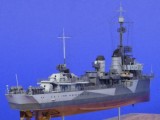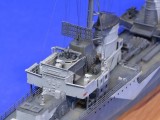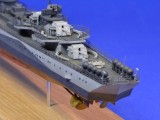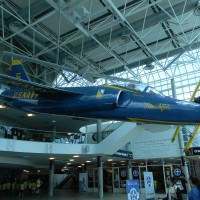Z-31 IN 1:350 FROM DRAGON
It cannot with the best of will be said, that the german destroyers of WW2 were successful designs. Their sleek hulls had far too little volume in the foreship to carry the artillery.
It was bad enough with the single 15 cm gun on the foredeck and it got far worse when the double 15 cm turrets of the original design were fitted. When there was a sea running, the ships would dive straight into the seas taking the water green over their bows all the way up to the turret. Of course it was impossible to keep the water out of the turret and sometimes important equipment in the turret would be put out of action.
Fitting the destroyers with 15 cm guns instead of the for destroyers usual 12 cm guns, seems logical when you read about the design process. The germans knew that they would always be inferior in numbers and therefore tried to give each individual ship more firepower than its potential opponent.
A 15 cm shell however, weighs some 45 kg, twice as much as a 12 cm shell. These heavy shells had to be manhandled by the gun crews aboard a ship that rolled and pitched much livelier than a cruiser, the type of ship that usually carries 15 cm guns.
The inevitable result was that the rate of fire went down drastically.
The machinery caused constant troubles. To reach high speeds, the germans fitted their destroyers with advanced high pressure turbines. When five destroyers were sent out on a mission, one usually had to turn back because of engine trouble. Not only was the technology new and untested, the engineers qualified to repair them were too few. This caused the destroyers to spend long periods in shipyards being repaired and overhauled.
On top of that, there were always to few destroyers and other small ships. The german navy was completely unprepared for the fact that they would have to keep the coastline from North Cape to Spain under surveillance. The loss of ten destroyers during the Narvik campaign didn't exactly make things better.
Dragons kit is very good. Even the waterline joint went together without any trouble worth mentioning. The PE set that comes with the kit is very fine, but it was quite tricky to fit the ventilator gratings around the base of the funnels. Building the mainmast and getting the crossed yardarms level, although the mast is inclined aft, was also a challenge. I did it by drilling an inclined hole through a piece of particle board and put the mast into it. The mast rested in the hole while I glued the yardarms to it.
The paravanes came from l'Arsenal and railings and other PE came from Eduard.
I finished the model in December 2014.
Even though the waterline joint of this kit went together without problems, I maintain that waterline joints should be prohibited.





















Outstanding job again, Ulf...you must have oodles of display space for all these [rather] large ship models. I must say, you have the assembly process down to the proverbial science. Beautiful work, sir.
Very, very nice, Ulf.
Another interesting example of the genre. Very nice.
Another masterpiece Ulf.
Masterful as ever.
Everyday a new discovery! Using graph paper to align PE parts and/or wire fabrication. Boy do I feel silly, I never used that method before, thanks for the tip, Ulf. By the way, do you air brush your ships or hand brush the camo paint scheme? Most builders apply their disruptive colors so thick and flat it looks like mud rather than paint. You apparently have the process down to a science. Exceptional work!
Thanks Mike.
I airbrush almost everything on my models. I only paint brush the portholes and other minute details. Also I do most of my weathering from the start using the airbrush, working with thin half transparent uneven layers of different nuances of the basic colour.
When applying washes I use a brush of course and also when making dirt or rust streaks. On this one though, I abstained almost entirely from washes as an experiment. Conclusion: Washes do have their place and I will continue to use them.
And yes, graph paper comes in handy sometimes. A friend gave me the tip a few years ago.
Another Ulf masterwork. Beautifu1!
Ulf, with all their problems, they sure look pretty. Thanks for the information, I always wondered why their Navy had such a tough time. Narvik wasn't the victory for them I always thought, huh? For a small force to start with, that's a real blow.
Another miniature masterpiece, always a pleasure to see what you've done.
It says a lot about the gambler Hitler, that he went to war with the major sea Power Great Britain, with a totally insufficient navy. (I've read somewhere that the total displacement of the Royal Navy was a hundred times that of the german navy. I haven't checked that figure though, so don't take it for an absolute fact.)
Also, Admiral Raeder and his likes, were stuck in an outdated "battleship strategy" that failed to realise the importance of the aircraft carrier.
Furthermore, even if Germany had planned to build more ships of other types, it didn't have the shipyard capacity to do it. Neither did it manage to build any substantial number of ships in the shipyards in the occupied countries, nor make use of the ships of these countries.
Lack of cooperation with the Luftwaffe was another important factor.
Hitlers meddling in how the ships were deployed didn't exaclty make things better.
Lastly, from 1942, fuel shortage was a very limiting factor, especially for the bigger ships.
PS. Although the norwegian campaign was a strategic success for Germany, it was a disaster for the navy. One heavy cruiser (of the three they had), two light cruisers and ten destroyers (of ca 30 I think) were lost
The Kriegsmarine never recovered from these losses.
Ulf,
Again I am at a loss for words so I will have to re-use FABULOUS once again.
Another impressive boat Ulf. Very nice work.